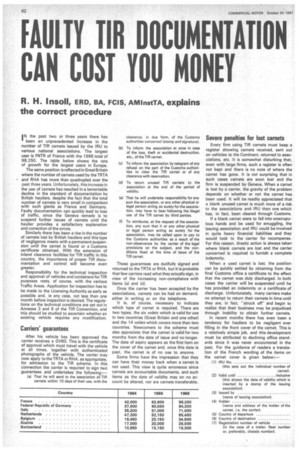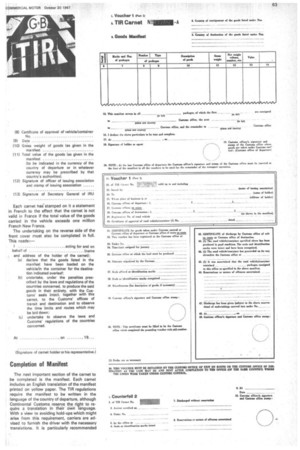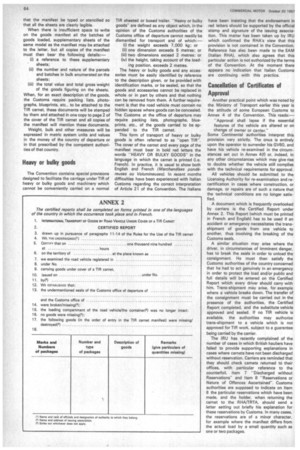FAULTY TIR DOCUMENTATION CAN COST YOU MONEY
Page 64

Page 65

Page 66

If you've noticed an error in this article please click here to report it so we can fix it.
R. H. I nsoll, E R D, BA, F C I S, AM I nstTA, explains the correct procedure
IN the past two or three years there has
been an unprecedented increase in the number of TIR carnets issued by the IRU to various national associations. The largest user is FNTR of France with the 1966 total of 98,250. The table below shows the rate of growth for the largest users in Europe.
The same position is reflected in Great Britain where the number of carnets used by the TRTA and RHA has more than quadrupled over the past three years. Unfortunately, this increase in the use of carnets has resulted in a lamentable decline in the standard of documentation by British hauliers, despite the fact that the total number of carnets is very small in comparison with such giants as France and Germany. Faulty documentation can quickly lead to loss of traffic, since the Geneva remedy is to suspend further issues of carnets until the haulier provides a satisfactory explanation and correction of the errors.
Similarly there has been a rise in the number of carnets lost by British hauliers and this type of negligence meets with a permanent suspension until the carnet is found or a Customs certificate obtained. With the extension of inland clearance facilities for TIR traffic in this country, the importance of proper TIR documentation and control will become even greater.
Responsibility for the technical inspection and approval of vehicles and containers for TIR purposes rests, of course, with the various Traffic Areas. Application for inspection has to be made to the Licensing Authority as early as possible and, in any case, not less than one month before inspection is desired. The regulations on the technical conditions are set out in Annexes 3 and 6 of the TIR Convention, and this should be studied to ascertain whether an existing vehicle requires any modification.
Carriers' guarantees
After his vehicle has been approved the carrier receives a GV60. This is the certificate of approval which must travel with the vehicle at all times, together with authenticated photographs of the vehicle. The carrier may now apply to the TRTA or R HA, as appropriate, for admission to the TIR scheme. In this connection the carrier is required to sign two guarantees and undertakes the following:— (al That he will send to the association all TIR carnets within 10 days of their use, with the clearance, in due form, of the Customs authorities concerned (stamp and signature).
(b) To inform the association at once in case of the loss, theft or accidental destruction. etc., of the TIR carnet.
(c) To inform the association by telegram of any refusal on the part of the Customs authorities to clear the TIR carnet or of any clearance with reservation.
(d) To return unused TIR carnets to the association at the end of the period of validity.
(e) That he will undertake responsibility for any sum the association, or any other physical or legal person acting as surety for the association, may have to bear following the illegal use of the TIR carnet by third parties.
If) To reimburse, at the request of the association, any sum that it or any other physical or legal person acting as surety for the association, may be called upon to pay to the Customs authorities as a result of the non-observance by the carrier of the legal provisions on the subject, and the conditions fixed at the time of issue of the TIR carnet, These guarantees are dutifully signed and returned to the TRTA or R HA, but it is probable that few carriers read what they actually sign, in view of the increasing non-compliance with items (a) and (d).
Once the carrier has been accepted by the associations, carnets can be had on demand, either in writing or on the telephone.
It is, of course, necessary to indicate which type of carnet is required. There are two types, the six volets which is valid for use in two countries (Great Britain and one other) and the 14 volets which covers more than two countries. Newcomers to the scheme must also appreciate that the carnet is valid for two months from the date of issue and no longer. The date of expiry appears as the first item on the cover of the carnet and, once this date is past, the carnet is of no use to anyone.
Some firms have the impression that they can have their money back when a carnet is not used. This view is quite erroneous since carnets are accountable documents, and such items as the date of validity may on no account be altered, nor are carnets transferable.
Severe penalties for lost carnets
Every firm using TIR carnets must keep a register showing carnets received, sent out on vehicles to the Continent, returned to associations, etc. It is somewhat disturbing that, even with large firms, such a register is often not kept and there is no note of where the carnet has gone. It is not surprising that in such cases carnets are soon lost and the firm is suspended by Geneva. When a carnet is lost by a carrier, the gravity of the problem depends on whether or not the carnet has been used. It will be readily appreciated that a blank unused carnet is much more of a risk to the associations and IRU than one which has, in fact, been cleared through Customs.
If a blank carnet were to fall into unscrupulous hands and be used for smuggling, the issuing association and I RU could be involved in quite heavy financial liabilities and they would look to the carrier for recompense. For this reason, drastic action is always taken where blank carnets are lost and the carrier concerned is required to furnish a complete indemnity.
When a used carnet is lost, the position can be quickly settled by obtaining from the final Customs office a certificate to the effect that the carnet was duly discharged. In both cases the carrier will be suspended until he has provided an indemnity or a certificate of discharge. Unfortunately, many carriers make no attempt to return their carnets in time until they are, in fact, "struck off" and begin to realize that their business may be prejudiced through inability to obtain further carnets_
In recent months there has even been a tendency for hauliers to be negligent over filling in the front cover of the carnet. This is a relatively simple job, and this development must be attributed to declining office standards since it was never encountered in the past. For the guidance of readers a translation of the French wording of the items on the carnet cover is given below:—
(1) IRU No. this sets out the individual number of carnet).
121 Valid until inclusive (this shows the date of validity which is inserted by a stamp of the issuing association).
(3) Issued by (name of issuing association).
(4) Holder (name and address of the holder of the carnet, i.e. the carrier).
(5) Country of departure (6) Country of destination {71 Registration number of vehicle (in the case of a trailer, fleet number or, preferably, chassis number). (8) Certificate of approval of vehicle/container No.
(9) Date (10) Gross weight of goods (as given in the manifest (11) Total value of the goods (as given in the manifest (to be indicated in the currency of the country of departure or in whatever currency may be prescribed by that country's authorities).
(12) Signature of officer of issuing association and stamp of issuing association (13) Signature of Secretary General of IRU
Each carnet has-stamped on it a statement in French to the effect that the carnet is not
valid in France if the total value of the goods carried in the vehicle exceeds one million French New Francs.
The undertaking on the reverse side of the front cover must also be completed in full. This reads:
1 acting for and on
behalf of (name and address of the holder of the carnet);
(a) declare that the goods listed in the manifest have been loaded on the vehicle/in the container for the destination indicated overleaf;
go) undertake, under the penalties prescribed by the laws and regulations of the countries concerned, to produce the said goods in their entirety, with the Customs seals intact, together with this carnet. to the Customs' offices of transit and destination and to observe the time limits and routes which may be laid down; lc) undertake to observe the laws and Customs' regulations of the countries concerned.
(Signature of carnet holder or his representative.)
Completion of Manifest
At on 19.
The next important section of the carnet to be completed is the manifest. Each carnet includes an English translation of the manifest printed on yellow paper. The TIR regulations require the manifest to be written in the language of the country of departure, although Continental Customs reserve the right to require a translation in their own language. With a view to avoiding hold-ups which might arise from this requirement, carriers are advised to furnish the driver with the necessary translations. It is particularly recommended that the manifest be typed or stencilled so that all the sheets are clearly legible. When there is insufficient space to write on the goods manifest all the batches of goods loaded, supplementary sheets of the same model as the manifest may be attached to the letter, but all copies of the manifest must then bear the following details:— 0) a reference to these supplementary sheets; (ii) the number and nature of the parcels and batches in bulk enumerated on the sheets; (iii) the total value and total gross weight of the goods figuring on the sheets. When, for an exact description of the goods, the Customs require packing lists, photographs, blueprints, etc., to be attached to the TIR carnet, these documents will be stamped by them and attached in one copy to page 2 of the cover of the TIR carnet and all copies of the manifest will mention these documents.
Weight, bulk and other measures will be expressed in metric system units and values in the money of the country of departure or in that prescribed by the competent authorities of that country.
Heavy or bulky goods
The Convention contains special provisions designed to facilitate the carriage under TIR of heavy or bulky goods and machinery which cannot be conveniently carried on a normal TIR sheeted or boxed trailer. "Heavy or bulky goods" are defined as any object which, in the opinion of the Customs authorities of the Customs office of departure cannot readily be dismantled for transport and of which:— (i) the weight exceeds 7,000 kg; or (ii) one dimension exceeds 5 metres; or (iii) two dimensions exceed 2 metres; or
(iv) the height, taking account of the loading position, exceeds 2 metres.
The heavy or bulky goods and any accessories must be easily identified by reference to the description given, or be provided with identification marks, or be sealed, so that the goods and accessories cannot be replaced in whole or in part by others and that nothing can be removed from them. A further requirement is that the road vehicle must contain no hidden spaces where goods can be concealed. The Customs at the office of departure may require packing lists, photographs, blueprints, etc., of the goods carried to be appended to the TIR carnet.
This form of transport of heavy or bulky goods is often referred to as "open TIR". The cover of the carnet and every page of the manifest must bear in bold red letters the words "HEAVY OR BULKY GOODS" in the language in which the carnet is printed (i.e. French). In practice, it is usual to show both English and French (Merchandises pondereuses ou Volumineuses). In recent months difficulties have been experienced with Italian Customs regarding the correct interpretation of Article 21 of the Convention. The Italians have been insisting that the endorsement in red letters should be supported by the official stamp and signature of the issuing association. This matter has been taken up by IRU which confirmed the R HA's view that this provision is not contained in the Convention. Reference has also been made to the EAM (Italian RHA), which also agrees that this particular action is not authorized by the terms of the Convention. At the moment there appears no indication that Italian Customs are continuing with this practice.
Cancellation of Certificates of Approval
Another practical point which was noted by the Ministry of Transport earlier this year is the attitude of some European Customs to
Annex 4 of the Convention. This reads:— -Approval shall lapse if the essential features of the vehicle are altered or on change of owner or carrier."
Some Continental authorities interpret this provision very strictly. The onus is entirely upon the operator to surrender his GV60, and have his vehicle re-examined in the circumstances set out in Annex 4(f) or, indeed, in any other circumstances which may give rise to doubts whether the vehicle still complies with the technical requirements for approval.
All vehicles should be submitted to the Licensing Authority for re-examination and recertification in cases where construction, or damage, or repairs are of such a nature that the technical conditions are no longer satisfied.
A document which is frequently overlooked by carriers is the Certified Report under Annex 2. This Report (which must be printed in French and English) has to be used if an accident or emergency necessitates the transshipment of goods from one vehicle to another, thus involving the breaking of the Customs seals.
A similar situation may arise where the driver, in circumstances of imminent danger, has to break the seals in order to unload the consignment. He must then satisfy the Customs authorities of the country concerned that he had to act genuinely in an emergency in order to protect the load and/or public and full details will be entered on the Certified Report which every driver should carry with him. Trans-shipment may arise, for example where a vehicle breaks down. The transfer of the consignment must be carried out in the presence of the authorities, the Certified Report completed, and the substitute vehicle approved and sealed. If no TIR vehicle is available, the authorities may authorize trans-shipment to a vehicle which is not approved for TIR work, subject to a guarantee being carried by the carrier.
The IRU has recently complained of the number of cases in which British hauliers have failed to provide supporting explanations in cases where carnets have not been discharged without reservation. Carriers are reminded that they should check carnets returned to their offices, with particular reference to the counterfoil. Item 7 -Discharged without Reservations" and Item 8 -Reservations or Nature of Offences Ascertained". Customs authorities are supposed to indicate on Item 8 the particular reservations which have been made, and the holder, when returning the carnet to the RHA/TRTA, should send a letter setting out briefly his explanation for these reservations by Customs. In many cases, the reservations are of a minor character, for example where the manifest differs from the actual load by a small quantity such as one or two packages.








































































































































